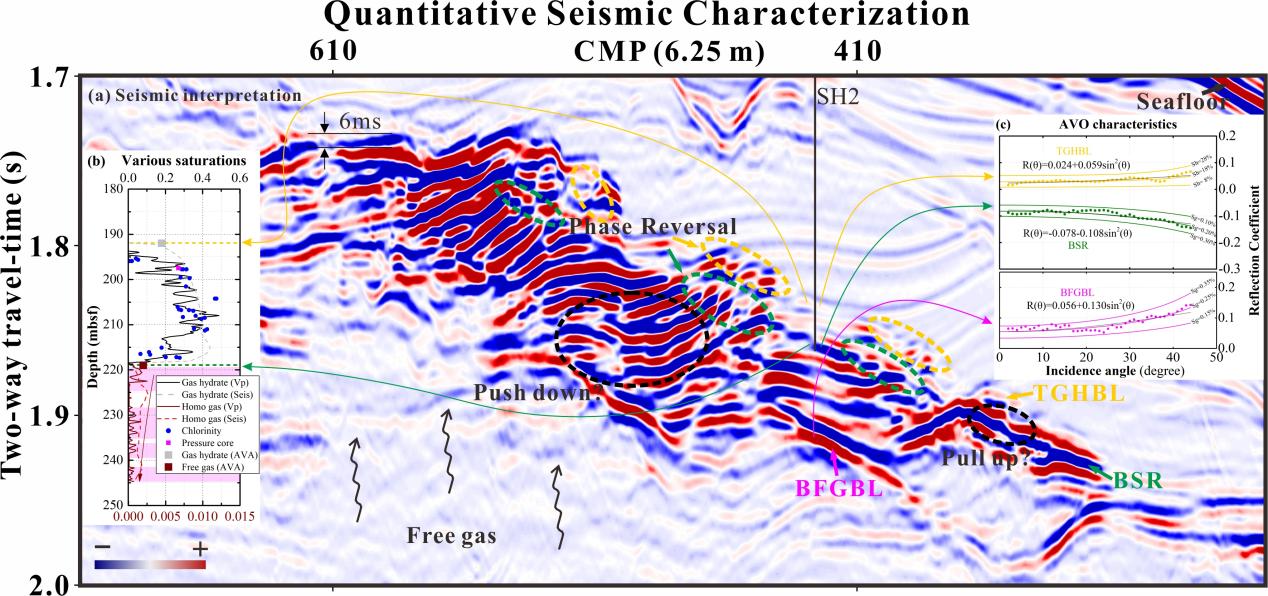During China's first gas hydrate drilling expedition, a gas hydrate-bearing layer (GHBL) of ≈25 m thickness was identified above a bottom-simulating reflection (BSR) at site SH2 in the Shenhu area, South China Sea.
At site SH2, gas hydrate saturations were calculated from resistivity and velocity, however, the pre-stack seismic characteristics of both GHBL and the free gas-bearing layer (FGBL), and gas distribution are not yet clear.
Recently, Dr. QIAN Jin from the Institute of Oceanology of the Chinese Academy of Sciences (IOCAS) considered the GHBL and the underlying FGBL as a whole and evaluated them using quantitative seismic characterization.
The study was published in Marine and Petroleum Geology on Feb. 25.
Two new reflections of normal polarity are identified at the top of the GHBL and the base of the FGBL. New phase reversals are also observed at the top of the GHBL and the base of the FGBL and change from negative polarity in the upper layer to positive polarity in the lower layer.
Seismic forward modeling illustrates that the phase reversals are primarily the results of varying saturations of gas hydrate and free gas, and that pull-ups and push-downs of reflections depend respectively on both the saturations and thicknesses of the GHBL and the FGBL.
"Because hydrate saturation is the only variable at the top of the GHBL, the new phase reversals at the top of the GHBL can be used as direct indicators of gas hydrate in similar formations," said Dr. QIAN.
At site SH2, Amplitude versus offset (AVO) analysis shows both Intercepts and Gradients at the top of the GHBL and the base of the FGBL are positive and occur in quadrant I, and their reflection coefficients increase with incidence angle, which is significantly different from that of the BSR. Gas hydrate saturation computed from AVO analysis is predicted to be ~18% at the top of the GHBL, and that of free gas to be ~0.25% at the base of the FGBL.
Away from site SH2, saturation estimations from inversion to acoustic impedance show that the maximum saturations computed from impedance are ~18% for free gas (assuming the homogeneous model), and ~50% for gas hydrate. Gas hydrate with high saturation is locally distributed and discontinuous near site SH2.
"The quantitative seismic interpretation presented in this study provides a reliable method for the assessment of the GHBL and the FGBL, especially in areas with no wells," said Dr. QIAN.
This work was supported by the National Natural Science Foundation of China and National Key R&D Program of China.

Quantitative seismic characterization for gas hydrate reservoirs
Qian Jin, Kang Dongju, Jin Jiapeng, Lin Lin, Guo Yiqun, Meng Mianmo, Wang Zhaoqi, Wang Xiujuan. (2022). Quantitative seismic characterization for gas hydrate- and free gas-bearing sediments in the Shenhu area, South China Sea. Marine and Petroleum Geology, 139, 105606.
QIAN Jin
Institute of Oceanology
E-mail: qianjin@qdio.ac.cn
(Editor: ZHANG Yiyi)

